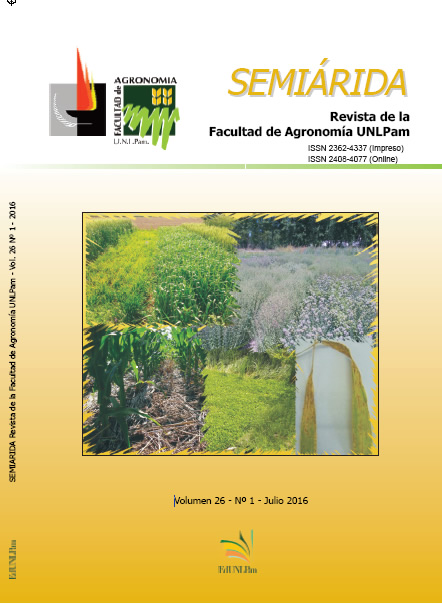Ver ítem
- xmlui.general.dspace_homeCentros Regionales y EEAsCentro Regional La Pampa - San LuisEEA AnguilArtículos científicosxmlui.ArtifactBrowser.ItemViewer.trail
- Inicio
- Centros Regionales y EEAs
- Centro Regional La Pampa - San Luis
- EEA Anguil
- Artículos científicos
- Ver ítem
Primera cita de Ramularia collo-cygni para la provincia de La Pampa (Argentina) = First reported case of Ramularia collo-cygni for la Pampa province, Argentina
Resumen
En la provincia de La Pampa, la superficie del cultivo de cebada se incrementó sustancialmente
en los últimos cuatro años. El salpicado necrótico de la cebada, cuyo
agente etiológico es Ramularia collo-cygni, está actualmente difundiéndose por la región
pampeana como una enfermedad emergente. El objetivo del presente trabajo fue diagnosticar
la enfermedad e iniciar la exploración de su distribución en la provincia de La
Pampa. Se realizaron análisis
[ver mas...]
En la provincia de La Pampa, la superficie del cultivo de cebada se incrementó sustancialmente
en los últimos cuatro años. El salpicado necrótico de la cebada, cuyo
agente etiológico es Ramularia collo-cygni, está actualmente difundiéndose por la región
pampeana como una enfermedad emergente. El objetivo del presente trabajo fue diagnosticar
la enfermedad e iniciar la exploración de su distribución en la provincia de La
Pampa. Se realizaron análisis fitopatológicos de muestras del norte y del sur de la provincia.
Se describieron e ilustraron los síntomas y signos relacionados con el primer reporte
de salpicado necrótico en La Pampa, como así también las características de R.
collo-cygni en medios agarizados.
[Cerrar]
The barley cropping area has been increased in La Pampa Province during the last four
years. An infection caused by Ramularia collo-cygni, a fungus that induces leaf necrotic
spotting in barley, is presently spreading across the Pampean Region as an emerging disease.
The goal of the present work was to carry out the diagnosis of this disease and initial
exploration of its distribution in La Pampa Province. Phytopathological analyses were
performed on
[ver mas...]
The barley cropping area has been increased in La Pampa Province during the last four
years. An infection caused by Ramularia collo-cygni, a fungus that induces leaf necrotic
spotting in barley, is presently spreading across the Pampean Region as an emerging disease.
The goal of the present work was to carry out the diagnosis of this disease and initial
exploration of its distribution in La Pampa Province. Phytopathological analyses were
performed on barley samples collected from the northern and southern areas of the province.
As results of this work, symptoms and signs of the disease are described and illustrated
in this article, as well as features of the pathogen development in different culture
media, giving way to the first report relating Ramularia leaf spot of barley for La Pampa.
[Cerrar]

Fuente
Semiárida : Revista de la Facultad de Agronomía, Universidad Nacional de La Pampa 26 (1): 29-33. (2016)
Fecha
2016
Editorial
Facultad de Agronomía, UNLPam
ISSN
2362-4337
2408-4077 (Online)
2408-4077 (Online)
Formato
pdf
Tipo de documento
artículo
Palabras Claves
Derechos de acceso
Abierto
 Excepto donde se diga explicitamente, este item se publica bajo la siguiente descripción: Creative Commons Attribution-NonCommercial-ShareAlike 2.5 Unported (CC BY-NC-SA 2.5)
Excepto donde se diga explicitamente, este item se publica bajo la siguiente descripción: Creative Commons Attribution-NonCommercial-ShareAlike 2.5 Unported (CC BY-NC-SA 2.5)


